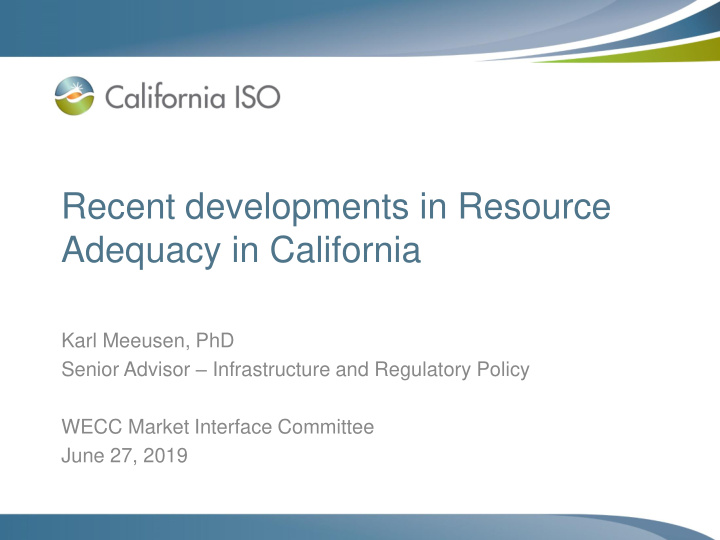



Recent developments in Resource Adequacy in California Karl Meeusen, PhD Senior Advisor – Infrastructure and Regulatory Policy WECC Market Interface Committee June 27, 2019
Overview • Overview • Recent developments at the CPUC • Centralized procurement and decentralized load service • Analyzing the RA fleet Page 2
What is resource adequacy in California • Multiple jurisdictional entities (currently over 30 different Local Regulatory Authorities) – Each LRA can establish its own RA rules • Multiple capacity products procured – System – Local – Flexible • RA resources must be made available to CAISO markets Page 3
California’s aggressive pursuit of a low carbon future must consider the future procurement landscape • Aggressive renewable energy goals 33% by 2020 100% 0-carbon by 2045 60% by 2030 • Deep greenhouse gas (GHG) reduction goals 2020 Target 2030 Target 2050 Target Reduce GHG emissions 40% below 80% below to 1990 levels 1990 levels 1990 levels • Robust electric vehicles goal: 1.5 million by 2025 • 12,000 MW of distributed generation by 2020; • 1.3 GW of battery storage by 2024 Page 4
California procurement landscape is changing rapidly • Significant changes to local RA procurement (D.19-02- 022) – Three years forward requirements (100%, 100%, 50%) – PG&E Other” local area requirements now disaggregated • Proposal in Assigned Commissioner and ALJ ruling in IRP on 6/20/19 (R.16-02-007) – RFO for each LSE to procure share of 2,000 MW new peak capacity online by 8/1/21 – Potentially extend of one or more OTC units – Require SCE to solicit 500 MW of capacity from existing resources without a contract past 2021 Page 5
California’s transition to a central buyer • Community Choice Aggregation – Government entity formed by cities and counties that assumes the load-serving responsibilities for its constituents – Chooses the electricity generation mix on behalf of its consumers without having to own the wires/infrastructure to move electricity • Challenges of the “load migration” to CCAs – IOUs don’t want to buy capacity for load they will not serve – No longer large LSE capable of buying grid-scale renewable resources needed for state to achieve its energy policy goals – CCAs may have distinct preferences about how best to serve load Page 6
Roles and obligations of a central buyer • Ensures state has an entity to procure resources given transition to many small LSEs • Could be an IOU, state-run or state-overseen entity • A central buyer can have various roles and obligations, depending on policy objectives: – Full vs. residual procurement – Procurement of different capacity types (system, local, and flexible) – Procurement only or also act as a market participant – Procurement duration (one year or up to 10) Page 7
CAISO is proposing to assess only RA portfolio to test adequacy under various load and net load conditions • Provides greater certainty that a broad mix of resources can meet CAISO operational needs – Including thermal, hydro, wind, solar, energy and availability limited resources, distributed energy resources • CAISO must assess how the shown RA fleet works collectively to meet system needs – Similar in concept to the collective deficiency test the CAISO conducts for local RA – Some resources may be more “effective” in ensuring reliable operations under different scenarios • Must balance modelling complexity with CAISO operational needs Page 8
Recommend
More recommend